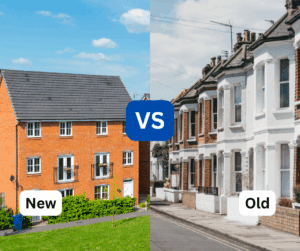The COVID-19 pandemic triggered one of the most dramatic shifts in the UK housing market in modern history. From the ‘race for space’ and a surge in remote working, to the migration away from cities and booming interest in coastal and rural areas, the property market between 2020 and 2021 was defined by urgency, unpredictability, and transformation.
Now, five years after the pandemic began, the UK property market is entering a new phase. With daily life back to normal and the economy adjusting, we’re starting to see a shift in the housing landscape. For investors, the key questions are: which pandemic-era trends are fading, which ones are still driving demand, and—most importantly—where are the strongest opportunities for returns right now?
City Comeback: Urban Revival in Full Swing
During the height of the pandemic, city life lost its lustre. With offices closed, social venues shuttered, and public transport seen as a risk, demand for urban properties dropped sharply. Buyers craved space, privacy, and access to nature — and were willing to trade convenience for tranquillity.
This sentiment shift led to a spike in interest for rural and coastal properties. In fact, in March 2021, Cornwall overtook London as the most searched location on Rightmove — a symbolic shift in buyer priorities.
Fast forward to 2025, and we’re witnessing a strong urban revival. London has reclaimed its position as the most-searched area. A majority of London-based buyers (58%) are now looking to remain in the city, up from under 50% during the pandemic. This resurgence indicates renewed confidence in city life — a return to office work, revitalised nightlife, and better infrastructure.
Investor insight: Properties in major urban hubs like London, Manchester, and Birmingham are regaining traction. For buy-to-let investors, this means stronger tenant demand, reduced void periods, and long-term capital growth potential — especially in well-connected city fringe areas.
The Coastal Cool-Off: Slower Sales and Stabilised Prices
Coastal properties, once the darlings of the pandemic era, are now taking longer to sell — currently averaging 73 days on the market, which is over three weeks slower than during the 2021 boom.
Price growth has also plateaued. During the rush, asking prices in seaside areas surged by 4.5% in a single year — almost double the national average at the time. Today, that growth rate has moderated to just 1% since 2024, bringing it in line with the rest of Great Britain.
What happened? As workers return to offices (at least part-time) and the novelty of coastal living wears off for some, demand is softening. At the same time, more coastal properties are returning to the market — potentially from second-home sellers or those relocating back to cities.
Investor insight: While the coast may no longer offer short-term gains, it remains a viable long-term play — particularly for furnished holiday lets or serviced accommodation targeting tourists. Investors should look for areas with strong year-round demand and diversify their strategy beyond seasonal short lets.
First-Time Buyer Squeeze: Affordability Still a Barrier
Although average wages have grown by 30% since the pandemic began — outpacing the 17% rise in first-home prices — the affordability gap for first-time buyers remains problematic.
Why? Because rental prices have skyrocketed — up 42% since 2020 — making it significantly harder for aspiring homeowners to save for a deposit. Combined with rising living costs and inflation, renters are finding it more difficult to break out of the rental trap.
Adding to this is the surge in mortgage rates. The average five-year fixed mortgage has jumped to 4.73%, compared to just 2.15% in 2020. For a typical buyer with a 20% deposit, monthly mortgage payments have increased by £359 over five years — from £590 to £949.
Investor insight: Demand in the rental market is red-hot, and likely to stay that way. Rental yields in commuter towns and affordable urban pockets could remain strong. Investors should target properties suitable for professionals and small families, with strong transport links and access to employment centres.
Space Still Commands a Premium
While some pandemic trends have faded, the desire for space has proven to be enduring. Detached and semi-detached homes have seen the strongest growth over the past five years — up 21% and 23%, respectively. In contrast, flats have lagged behind with just 7% growth.
Type of Home | Avg. Asking Price | 5- Year Price Growth |
Overall | £371,870 | 19% |
Bungalow | £342,518 | 21% |
Flat | £304,526 | 7% |
Terraced House | £303,622 | 20% |
Semi-Detached House | £326,918 | 23% |
Detached House | £545,869 | 21% |
Buyer searches also reflect this. In both 2020 and 2025, “garage” remains the most searched keyword on Rightmove, followed by “annexe”, “rural”, and “garden” — pointing to continued demand for internal and external space.
| Buyer keywords March 2025 |
1 | Garage |
2 | Annexe |
3 | Rural |
4 | Garden |
5 | Acre |
Investor insight: Investing in family-sized homes or properties with potential to extend (lofts, annexes, garages) could yield higher long-term returns. These features are not only sought after by buyers but can also command premium rents from long-term tenants.
Evolving Tenant Priorities: Pets Still Rule
For tenants, the ability to have pets remains the top priority in 2025, just as it was in 2020. Interestingly, “bills included” has dropped out of the top five tenant search terms — after peaking in popularity in 2022 when energy prices were at their highest.
| Top Tenant Keywords – March 2025 |
1 | Pets |
2 | Garage |
3 | Garden |
4 | Furnished |
5 | Parking |
Investor insight: Pet-friendly properties remain in high demand, and landlords willing to accommodate pets (with proper safeguards and deposits) may find it easier to fill vacancies and increase tenant retention. Additionally, off-street parking and outdoor space are still big draws in the rental market.
Outlook for Investors in 2025: Timing and Strategy Matter
The market in 2025 is looking increasingly like a buyers’ market, which could work in favour of strategic investors. Areas that experienced runaway price growth during the pandemic may now present better entry points, especially as supply increases and competition softens.
Meanwhile, demand for rental homes is soaring — especially in cities and affordable commuter areas — providing a solid foundation for buy-to-let investment.
Key takeaways for investors:
– Cities are back: Urban property is regaining momentum, offering stable long-term value.
– Rental demand is booming: Rising rents and first-time buyer challenges favour landlords.
– Space sells: Properties with outdoor areas, annexes, and garages remain highly desirable.
– Interest rates may stay elevated: Factor in higher borrowing costs and stress test your portfolio.
– Holiday lets need careful evaluation: Seasonal markets like the coast may need more refined yield strategies.
As the dust settles from the pandemic-era disruptions, clarity is returning to the property landscape. For investors who are ready to adapt — and prepared to buy wisely — 2025 could present some of the best opportunities we’ve seen in years.
If you’re considering a new investment or rebalancing your portfolio, let our data guide your decisions. Market conditions may have changed, but the fundamentals of smart investing — location, timing, and understanding buyer/renter demand — are more relevant than ever.







